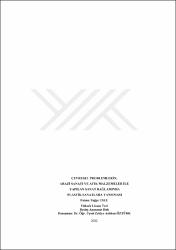| dc.contributor.advisor | Öztürk, Zekiye Aslıhan | |
| dc.contributor.author | Uslu, Fatma Tuğçe | |
| dc.date.accessioned | 2023-04-27T20:41:16Z | |
| dc.date.available | 2023-04-27T20:41:16Z | |
| dc.date.issued | 2022 | |
| dc.identifier.uri | https://tez.yok.gov.tr/UlusalTezMerkezi/TezGoster?key=kIrIdtdJ31bRgjb6fHvMURFc0P4RoU4qn7lBpQCsbvlkfLdnD3IPywUn_zkFfv7- | |
| dc.identifier.uri | https://hdl.handle.net/20.500.11776/11693 | |
| dc.description.abstract | İnsanların var olmaya başladığı dönemlerden günümüze kadar geçen zamanda insanın doğa ile olan ilişkisi, belli başlı tahribatların oluşmasına sebep olmuştur. Savaşlar, sanayileşme, nüfus artışı, kentleşme ve tüketim gibi problemler, üzerinde yaşadığımız gezegenimiz olan Dünya'nın kalıcı hasarlar almasını sağlamıştır. 20. yy'dan sonra bu tahribatın artık göz ardı edilemeyecek seviyeye gelmiş olması, sanatçıların bakış açısının değişmesine ve bu döneme kadar sanatta yer edinmiş doğa tasvirinin değişmesine yol açmıştır. 1960'lı yıllarda doğa ile iç içe yapılan sanat çalışmalarının artması ve fikir temelli üretimin yoğunlukta olması, malzeme ve mekan kullanımında değişikliğe gidilmesini doğurmuştur. Sanat mekanları olarak doğayı benimseyen ve doğal malzemeler ile çalışmalar yapan Arazi Sanatı sanatçılarının, tabiata verilen zarara eleştiri niteliğinde işler ortaya koydukları görülmektedir. Bunun yanı sıra oluşan tahribata, doğaya ait olmadığı halde doğaya atılan atık malzemeler ile çalışmalar yaparak tepki gösteren sanatçılar da mevcuttur. Atık malzemeler ile yapılan sanat çalışmaları, toplumun fazla üretim ve tüketim problemini, çevre kirliliği sebebiyle oluşan ekolojik bozulmaları ve diğer canlıların habitatının kısıtlanması durumunu eleştirmektedir. 1960'lardan beri çevresel hassasiyet barındıran çalışmaların günümüze kadar çoğalarak devam ettiği görülmektedir. Yeni kavramların meydana gelmesi ve mevcut kavramların tanımlamalarının derinleşmesiyle birlikte, önceden üretilmiş olan ve süreci devam eden çalışmalar güncel kavramlar ile yeniden değerlendirilmektedir. Yapılan bu çalışmada, gelişmekte ve biçim değiştirmekte olduğu görülen kavramların, bu süreç içinde yapılan çalışmalara nasıl entegre olduğu incelenmiştir. 1960 sonrası sanatçıları ve akımları konusunda gelişim süreci devam eden sınıflandırmalar yapılmış olup, değişen Dünya düzenine yapılan doğrudan ya da dolaylı eleştirilerin, sanat çerçevesinde nasıl ele alındığı araştırılmıştır. Sanat değeri olmayan neslerin bir imgeleyen pozisyonunda izleyiciye sunulması, eser, sanatçı ve izleyici üçgenini daha çok vurgular hale getirerek, izleyicinin asıl özne olduğunun altını çizmiştir. | en_US |
| dc.description.abstract | From the times when people began to exist to the present, the relationship of human with nature has caused certain destructions. Problems such as wars, industrialization, population growth, urbanization and consumption have caused permanent damage to our planet, the Earth. The fact that this destruction has reached a level that cannot be ignored anymore after the 20th century, has led to a change in the perspective of the artists and a change in the depiction of nature that has taken place in art until this period. In the 1960s, the increase in art works intertwined with nature and the intensity of idea-based production caused the change in the use of materials and space. It is seen that Land Art artists, who adopt nature as art spaces and work with natural materials, produce works that criticize the damage given to nature. In addition, there are artists who react to the destruction by working with waste materials thrown into nature, although they do not belong to nature. Art works made with waste materials criticize the problem of overproduction and consumption of the society, ecological deterioration due to environmental pollution and the restriction of the habitat of other living things. It is seen that since the 1960s, environmental sensitivite studies have continued to increase. With the emergence of new concepts and the deepening of the definitions of existing concepts, previously produced studies and ongoing processes are re-evaluated with current concepts. In this study, it has been examined how the concepts that are seen to be developing and changing form are integrated into the studies done in this process. Classifications were made about the artists and their movements after 1960, and it was investigated how the direct or indirect criticisms of the changing world order were handled within the framework of art. Presenting objects with no artistic value to the viewer in the position of an imaginative emphasizes the triangle of art, artist and viewer more and underlines that the viewer is the main subject. | en_US |
| dc.language.iso | tur | en_US |
| dc.publisher | Tekirdağ Namık Kemal Üniversitesi | en_US |
| dc.rights | info:eu-repo/semantics/openAccess | en_US |
| dc.subject | Güzel Sanatlar | en_US |
| dc.subject | Fine Arts | en_US |
| dc.title | Çevresel problemlerin, arazi sanatı ve atık malzemeler ile yapılan sanat bağlamında plastik sanatlara yansıması | en_US |
| dc.title.alternative | Reflection of environmental problems on plastic arts in the context of land art and art made with waste materials | en_US |
| dc.type | masterThesis | en_US |
| dc.department | Enstitüler, Sosyal Bilimler Enstitüsü, Resim Ana Sanat Dalı | en_US |
| dc.identifier.startpage | 1 | en_US |
| dc.identifier.endpage | 106 | en_US |
| dc.institutionauthor | Uslu, Fatma Tuğçe | |
| dc.relation.publicationcategory | Tez | en_US |
| dc.identifier.yoktezid | 771742 | en_US |



















